
The 2024 Summer Olympics have just kicked off in Paris.
You may be rooting for your favorite elite athletes, hoping to witness them shatter records. But as performances improve and records get increasingly harder to surpass, will athletes ever reach the limits of what is possible?
The hammer throw may have already met this fate — no one has broken its world record since 1986. Yet, athletes frequently outdo themselves in other sports, such as the 400-meter sprint.
Biophysical constraints on muscles — as well as other factors, such as reaction time — could set a limit on human achievement, experts told Live Science. However, innovative techniques and improved sportswear could help athletes continue to unlock new levels of performance.
Related: Why is it harder for some people to build muscle than others?
The limitations of muscles
Olympians often boast impressive muscles, but bigger gains don't necessarily lead to improvements in athleticism. This is partly because muscles lose efficiency as they grow.
Kevin Murach, a muscle researcher at the University of Arkansas, told Live Science that the most-efficient muscles contract along a line between two tendons. However, as they expand, muscles contract at a less-efficient, oblique angle. Overall, more muscle mass produces extra force, but the returns diminish as muscle mass continues to grow — and muscles will eventually approach a hard limit on what they can achieve.
What's more, huge muscles could even curtail athletes in some sports, such as sprinting. On one hand, enlarged muscles endow a sprinter with more force and thus help them overcome inertia — the tendency of an object at rest to stay at rest — upon starting. However, "there's probably a point at which you don't want your muscles to be super large," Murach said. "You wouldn't want to have so much that it became an anchor."
Besides muscle size, an athlete's dominant type of muscle fiber can affect their performance. There are two main types of muscle fibers: fast-twitch and slow-twitch.

"If you look at a sprinter, they have a high proportion of fast-twitch fibers as opposed to a marathon runner, who has a high proportion of slow-twitch fibers," John Hawley, an exercise physiologist who heads the Exercise & Nutrition Research Program at the Australian Catholic University, told Live Science. Fast-twitch fibers are richer in energy stores, produce more explosive movements and fatigue more quickly than the slow-twitch variety, he said.
This imposes a speed limit on high-endurance sports, such as long-distance running. Because of this, "I don't know if we will ever be at a place where you can run a marathon at a sprinting pace," Murach said.
The influence of technique and gear
Muscles set a ceiling on how hard athletes can work, but performance also depends on what athletes do with their muscles.
In the 1968 Olympics, Dick Fosbury used an innovative strategy for the high jump that literally raised the bar. Instead of soaring forward over the pole, he rotated his body midflight. The backward jump enabled him to arc his body and lower his center of mass so he could leap over the pole with less effort. Five years later, Dwight Stones perfected the "Fosbury flop" and surpassed the high-jump world record using this method.
Related: 'Muscle memories' get 'zipped and unzipped' in the brain, like computer files
"Now you won't find a high jumper in the world — you may find one out of 100 — who doesn't use that technique," Hawley said. This means that a physical peak doesn't necessarily prevent records from being broken in the future.
Improvements in sportswear can also boost performance significantly. For example, athletes wearing polyurethane-coated swimsuits broke 25 world records in the 2008 Olympics. One hypothesis is that "the polyurethane panel laminated over the fabric could prevent the air in the fabric from escaping from the costume [swimsuit] when the athlete entered the water," Ada Ferri, a textile engineer at the Polytechnic University of Turin in Italy, told Live Science in an email.

A tiny amount of trapped air might have given the contestants an edge by producing some buoyancy, she suggested. "As races are won by a few hundredths of a second, even buoyancy of a few millimetres can be decisive," Ferri said. Polyurethane swimsuits were later banned from competition, in 2010. However, this hasn’t stopped athletes from surpassing records, suggesting swimmers' actual performance still hasn't hit a ceiling.
Since 2016, shoes equipped with carbon-plated insoles can give runners an advantage, Ferri said. This type of footwear limits energy loss through the shoe's shock-absorbing midsole, meaning the runner has to put in less work to run faster. World Athletics, an organization of track-and-field federations, allows athletes to compete with these shoes as long as the foam base is no higher than about 1.6 inches (4 centimeters), so it's possible this sportswear could lead to new running records.
More broken records to come?
Other factors can influence performance, such as an athlete's diet, their psychological state or their mode of training.
For example, cyclists and runners train at high altitudes, driving their bodies to produce more oxygen-carrying red blood cells. However, Ferri argued that these additional factors produce gradual advances in performance. Huge leaps tend to be linked to breakthroughs in designing materials and equipment, she said.
Historically, more men than women have competed in sports and Olympic events. So, most of the research about athletic achievement has been based on male anatomy and there is a shortage of data on female physiology. Learning better training methods geared specifically toward female athletes could bring about the greatest performance gains, Ferri hypothesized.
"For the first time at the next Olympics in Paris, the percentage of female and male athletes will be [closer to] equal," Ferri said. The more female athletes who compete, the more likely that some will surpass previous milestones, so an even split between the sexes might lead to more broken records.
Hawley noted that historically, most advances in athletic performance were breached through trial and error, and scientists only later began studying the reasons why they occurred. But science now has a growing presence in sports.
With more data monitoring, "we will have a goldmine of information that athletes and coaches can use to make informed decisions about strategies in training and competition, Ferri said. This might streamline new breakthroughs that push athletes to set new all-time bests.
This article is for informational purposes only and is not meant to offer medical or athletic training advice.
Ever wonder why some people build muscle more easily than others or why freckles come out in the sun? Send us your questions about how the human body works to community@livescience.com with the subject line "Health Desk Q," and you may see your question answered on the website!







